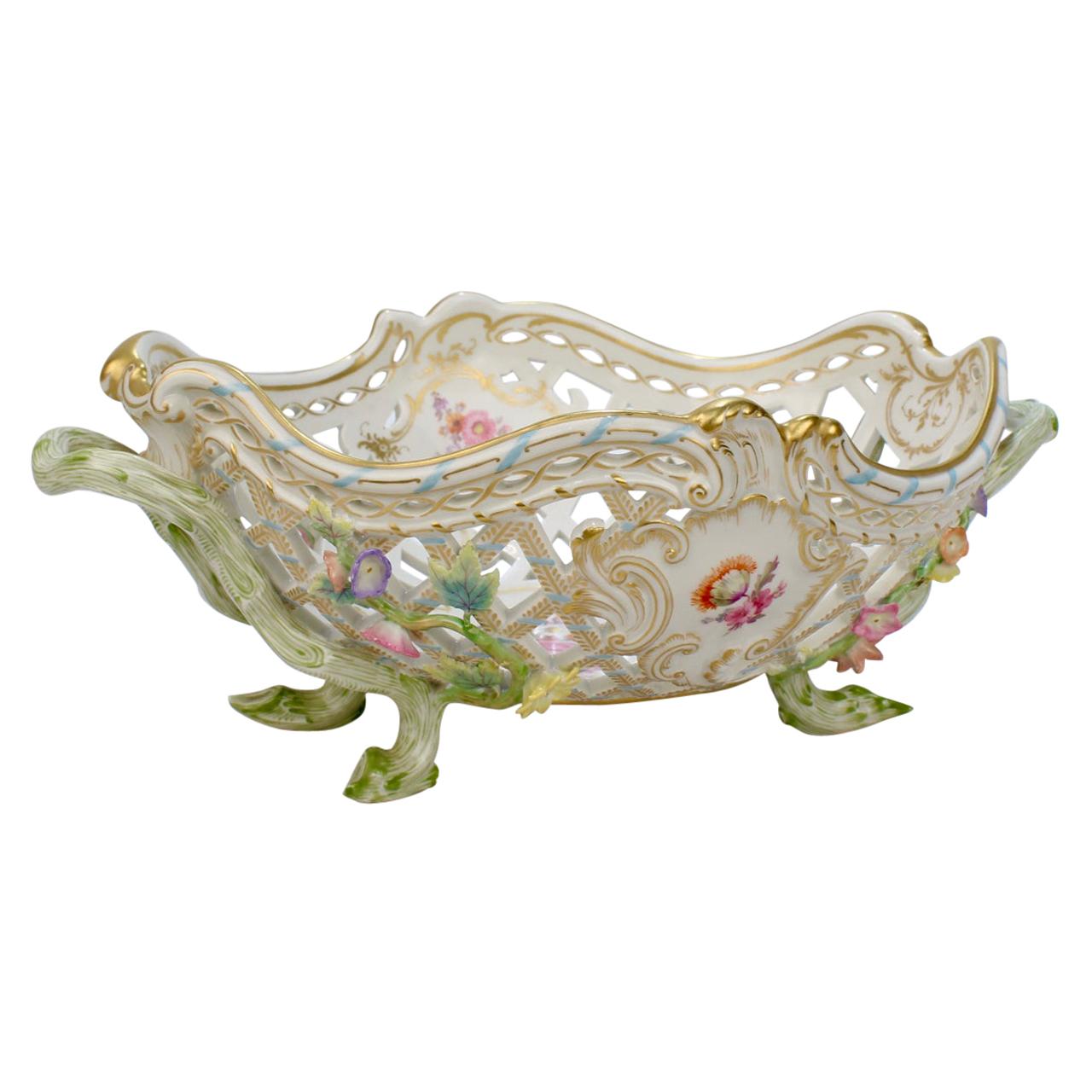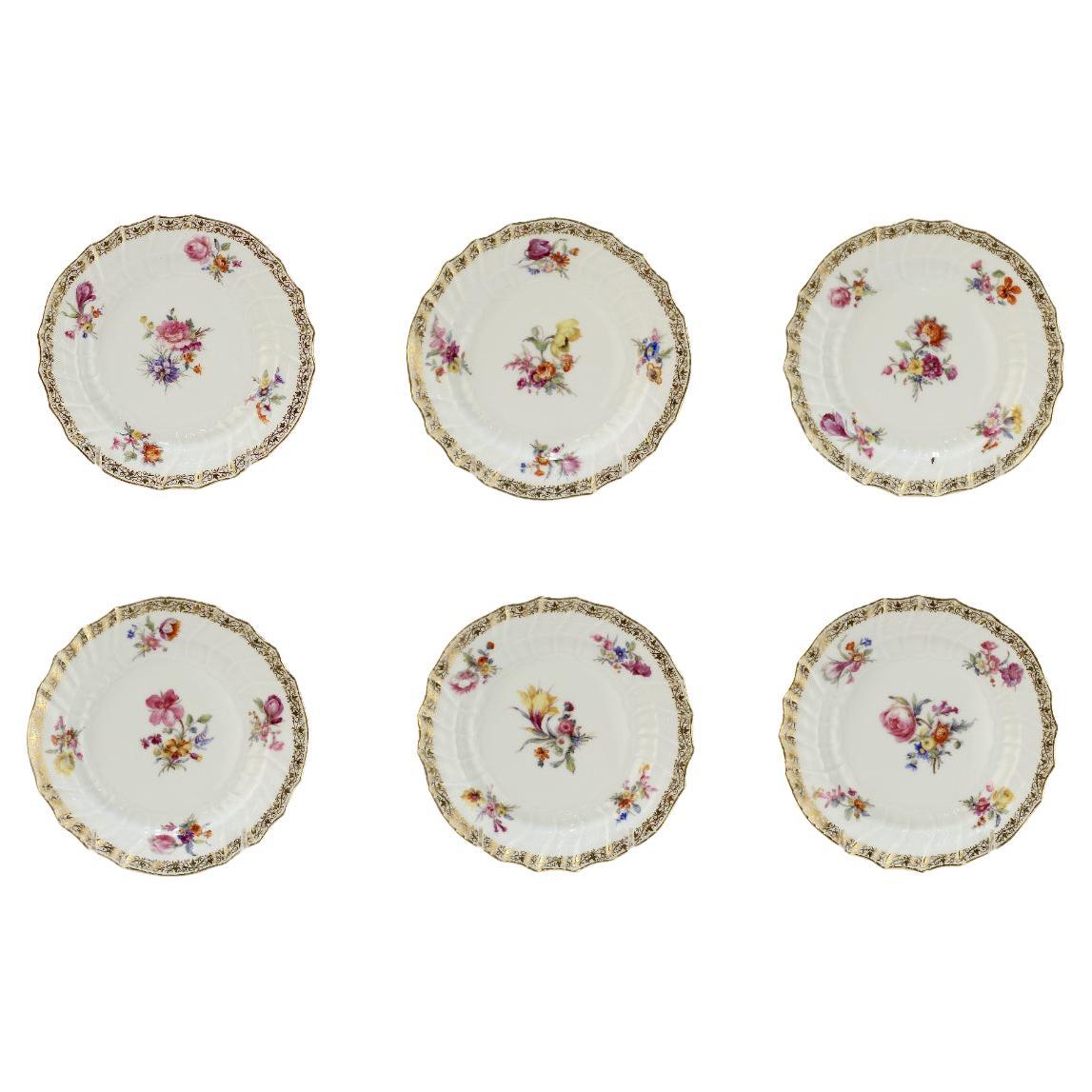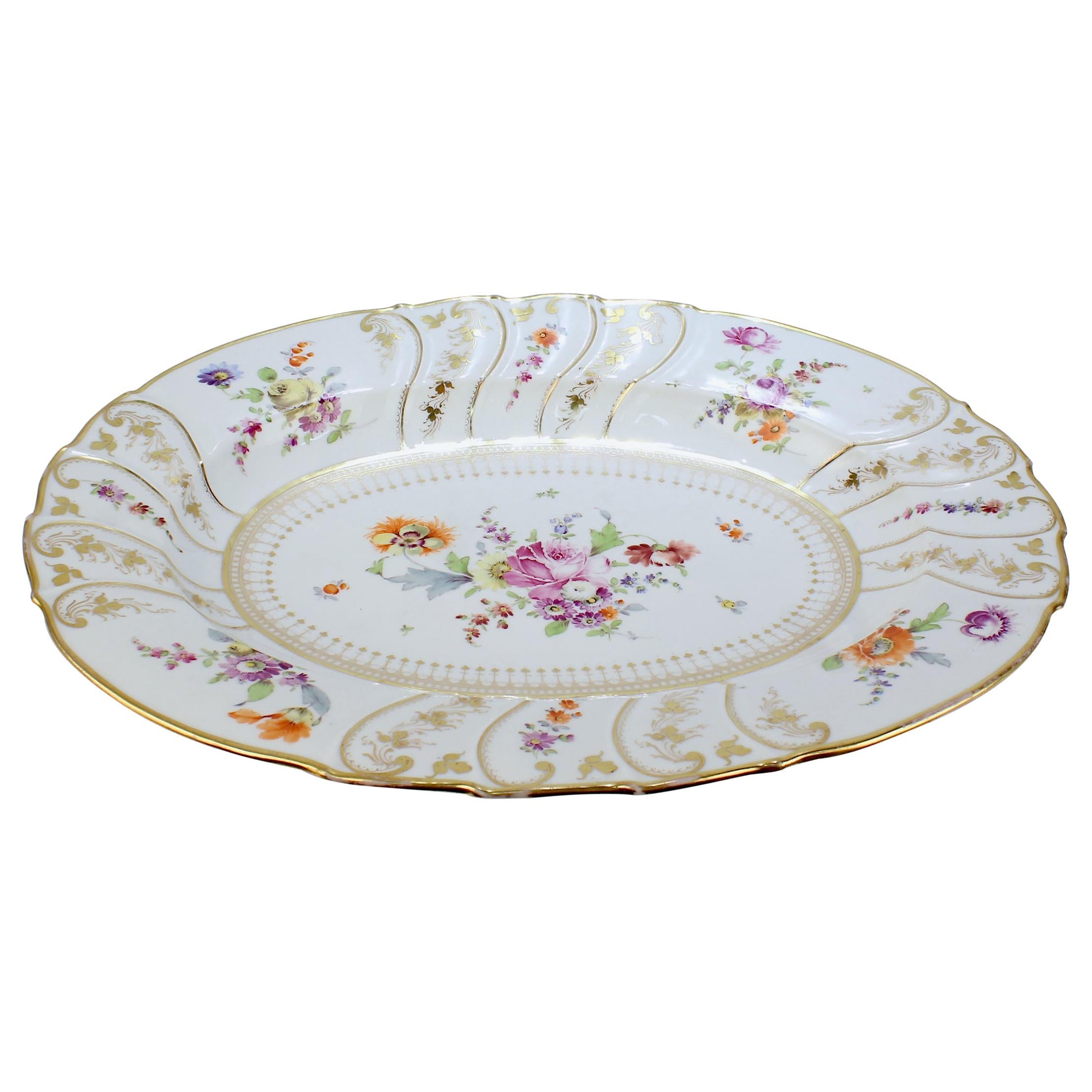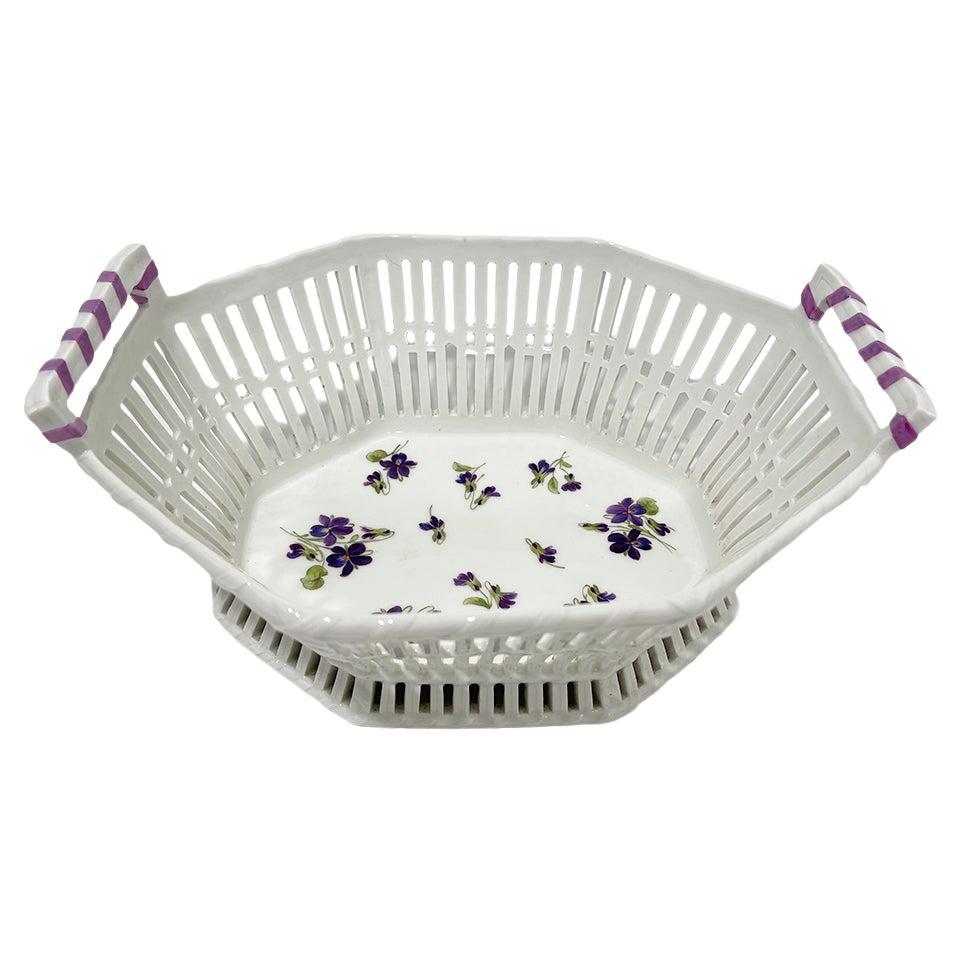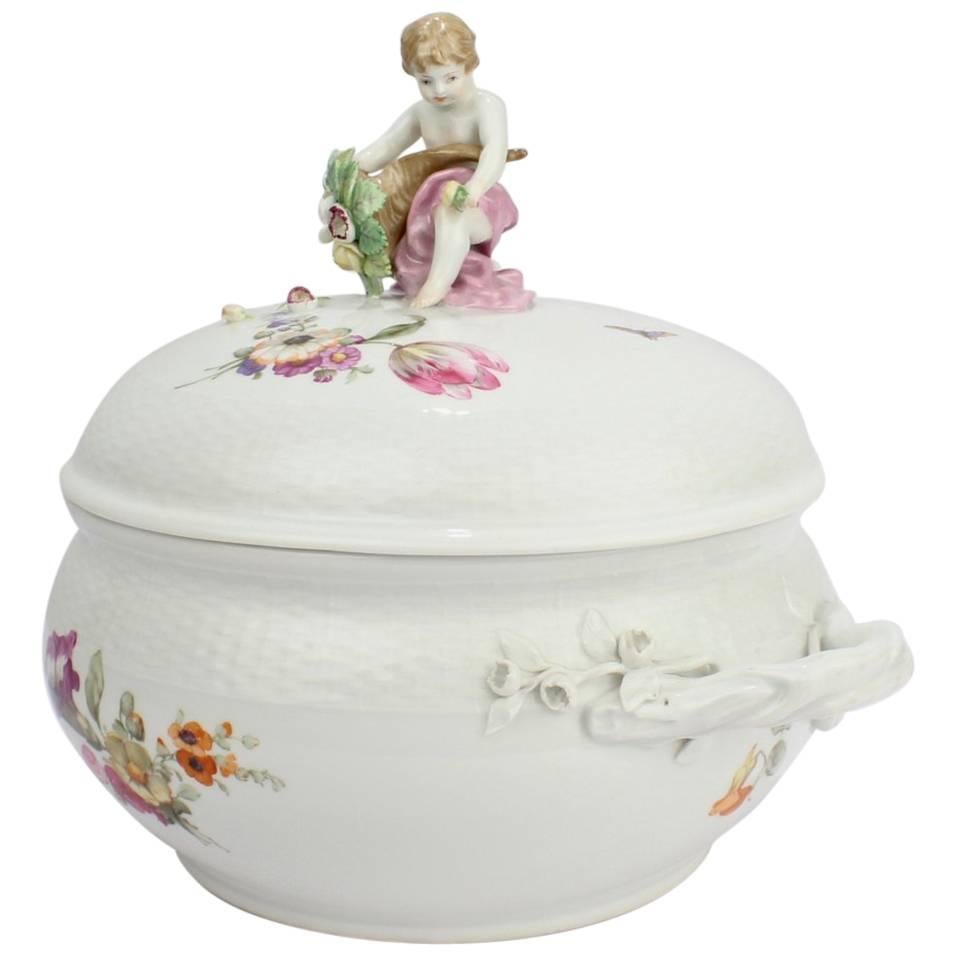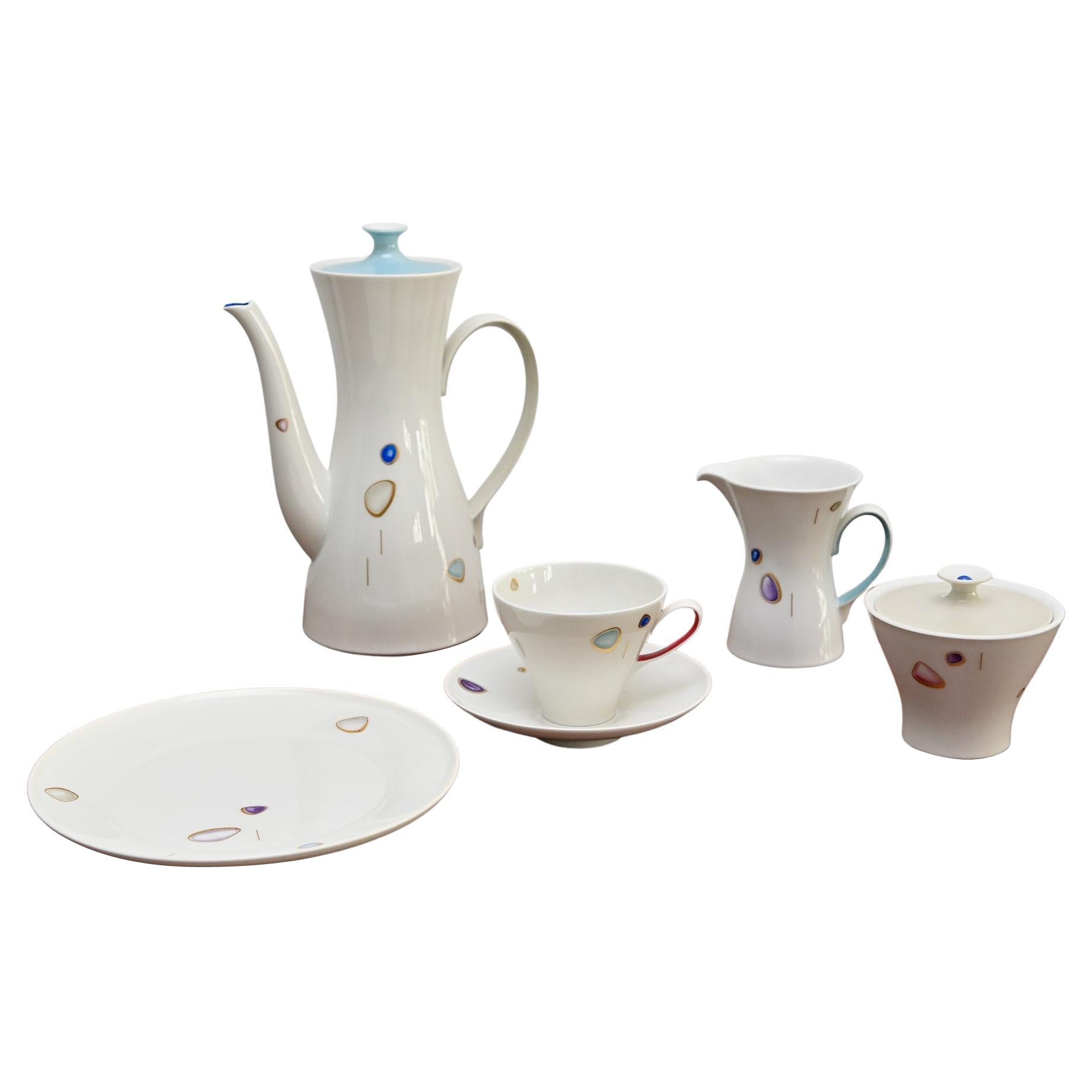Antique KPM Royal Berlin Reticulated Porcelain Basket with Deutsche Blumen Decor
About the Item
- Creator:KPM Porcelain (Maker)
- Dimensions:Height: 2.75 in (6.99 cm)Diameter: 5.75 in (14.61 cm)
- Style:Rococo (In the Style Of)
- Materials and Techniques:
- Place of Origin:
- Period:
- Date of Manufacture:Late 19th or Early 20th Century
- Condition:Wear consistent with age and use.
- Seller Location:Philadelphia, PA
- Reference Number:
KPM Porcelain
The Königliche Porzellan-Manufaktur Berlin, or KPM (Royal Porcelain Factory, Berlin, in English) was one of the most influential porcelain factories to emerge in 18th-century Germany, along with Nymphenburg and Meissen. KPM was the third incarnation of a company originally founded in 1751 by Wilhelm Caspar Wegely to take advantage of the burgeoning market for “white gold.” On the verge of bankruptcy, Wegely sold his inventory and tools to Johann Ernst Gotzkowsky, who in 1761 established another porcelain factory, which also failed, and was subsequently taken over by Frederick II of Prussia in 1763. Like Augustus II, Elector of Saxony, the patron of Meissen and a keen collector who described himself as suffering (quite happily) from “porcelain sickness,” Frederick II was proud to refer to himself as KPM’s “best customer.” KPM produces china and figurines to this day, and throughout its long history, it has been a style-setter for elegant tableware, particularly in the 1930’s, the period during which their popular patterns Urbino, Urania and Arkadia were designed.
Thanks to its royal patronage, KPM had the resources and contacts necessary to establish itself as a leading luxury producer, and supplied Russian and European elites with tableware in the Rococo and Neoclassical styles, as well as monumental vases, and decorative plaques. Many of these objects can be found today in major museums as a result of Frederick II’s penchant for sending KPM porcelain as diplomatic gifts throughout Europe. Unlike Meissen, which was known for crafting porcelain sculptures of dazzling complexity, KPM is revered for the precision and splendor of its surface decoration, and for its porcelain plaques depicting scenes from history and mythology. One especially lovely example circa 1790 is a neocalssical-style tea service decorated with gold accents and a grisaille design of figures from the ancient world. By contrast, this boldly colorful narrative cup and saucer set from the 1840’s depicts scenes from real life as colorfully as a painting. The set was commissioned by a gentleman for his wife as a tongue-in-cheek gift commemorating her misadventures while in town for a visit to the opera, which resulted in her opera glasses being stolen. The saucer shows the thief and the glasses, and the cup reveals the scene of the crime in vivid hues.
KPM was forced to move from its original location in 1867 due to the building of the new Prussian Parliament building, and this afforded the company the opportunity to to create a new factory with the newest equipment and materials of the day. With the growing popularity of Art Nouveau and the western fascination with Asian ceramics, KPM began formulating glazes that evoked the color palette and rich surfaces of Chinese porcelain. By the turn of the century, KPM was exhibiting its wares to a global audience at international expositions. At the end of World War I with the collapse of the Prussian monarchy, KPM was renamed the State Porcelain Manufactory Berlin, continuing to use the name KPM and its use of the cobalt blue sceptre mark that is painted on the bottom of every piece.
By the late 1920’s, the designers and craftsmen of KPM were inspired by the tenets of Modernism, particularly the styles of the Bauhaus and the Deutscher Werkbund. During this period, the firm’s aim was to produce useful household porcelain for a range of consumers, rather than catering to a small elite. Among the most successful patterns of this era was designer Trude Petri’s Urbino line, which is still produced today. Following World War II, KPM was temporarily housed in the town of Selb, and only returned to its rebuilt quarters in Berlin in 1957. In the 1980s, KPM became an private company independent of the state, and began to focus production on the preservation of historic forms, designs, and techniques. KPM continues to collaborate with designers from all over the world, most recently on the Berlin dinnerware service with designer Enzo Mari, and a collaboration with the luxury brands Bottega Veneta and Bugatti.
- ShippingRetrieving quote...Ships From: Philadelphia, PA
- Return PolicyA return for this item may be initiated within 7 days of delivery.
- Antique KPM Royal Berlin Porcelain Flower Encrusted Reticulated Fruit BasketBy Königliche Porzellan-Manufaktur (KPM)Located in Philadelphia, PAA very fine, antique KPM porcelain flower encrusted fruit basket. With traditional twig form handles and feet, an openwork body, flower encrus...Category
Antique 19th Century German Rococo Planters, Cachepots and Jardinières
MaterialsPorcelain
- Set of 6 Antique Kpm Royal Berlin Cake or Dessert Plates with Deutsche BlumenBy Königliche Porzellan-Manufaktur (KPM)Located in Philadelphia, PAA fine set of 6 Neuosier pattern antique porcelain cake plates. By KPM (Königliche Porzellan-Manufaktur) With Deutsche Blumen decor to the center...Category
Early 20th Century German Rococo Revival Porcelain
MaterialsPorcelain
- Large Antique Richard Klemm Dresden Porcelain Platter with Deutsche Blumen DecorBy Dresden PorcelainLocated in Philadelphia, PAA fine and large Dresden porcelain tray or platter by Richard Klemm. With a ribbed, scalloped border and deep central well. Richly decorated with ...Category
Antique Late 19th Century German Rococo Platters and Serveware
MaterialsPorcelain
- Antique KPM Royal Berlin Porcelain Hand-Painted Tureen with Cornucopia & CherubBy KPM PorcelainLocated in Philadelphia, PAA fine antique KPM porcelain tureen with flower encrusted handles, Deutsche Blumen floral sprays, and a figural cherub and cornucopia finial. ...Category
Early 20th Century German Porcelain
MaterialsPorcelain
- Pair Antique 18c Meissen Neuer Ausschnitt Porcelain Plates with Deutsche BlumenBy Meissen PorcelainLocated in Philadelphia, PAA fine pair of antique Neuer Ausschnitt (New Cut) pattern porcelain plates. By the Royal Meissen Porcelain Manufactory. Decorated with Deutsche Blumen...Category
Antique 18th Century German Rococo Porcelain
MaterialsPorcelain
- Antique KPM Royal Berlin Porcelain Neuosier Pattern Fruit BowlBy Königliche Porzellan-Manufaktur (KPM)Located in Philadelphia, PAA fine antique porcelain Neuosier pattern fruit bowl. By KPM (Königliche Porzellan-Manufaktur). The bowl has a bouquet of purple & white pan...Category
Early 20th Century German Rococo Serving Bowls
MaterialsPorcelain
- Octagonal Openwork Porcelain Basket by Kpm, Berlin 1870-1892By Königliche Porzellan-Manufaktur (KPM)Located in Delft, NLAn octagonal openwork porcelain basket by KPM, Berlin 1870-1892 KPM (Königliche Porzellan-Manufaktur Berlin) Royal Porcelain Manufactory Berlin...Category
Antique 19th Century German Porcelain
MaterialsPorcelain
- KPM Royal Berlin Design by Griemert Porcelain Coffee Set, Decor by von UnruhBy KPM PorcelainLocated in Epfach, DE20th Century KPM Royal Berlin coffee or mocca set porcelain 41 pieces form Krokus design by Griemert , decor by Siegrid von Unruh made 1953 mid century KPM ROYAL Berlin Crocus patte...Category
Mid-20th Century German Mid-Century Modern Porcelain
MaterialsPorcelain
- Antique Reticulated Chinese Famille Rose Medallion Porcelain Bowl or BasketLocated in Bad Säckingen, DEThis antique late Qing handpainted oval shaped reticulated Chinese export porcelain Famille Rose Medallion bowl with underplate is a stunning piece o...Category
Antique 1850s Qing Decorative Bowls
MaterialsPorcelain
- Berlin KPM Guild Royal Blue Porcelain VaseBy Königliche Porzellan-Manufaktur (KPM)Located in Guaynabo, PRBerlin KPM pedestal vaulted vase. It is hand painted on the front with a scene of Kronprinzepalais building redesigned by Johann Heinrich Strack for Prince Frederick William of Pruss...Category
Antique 19th Century German Rococo Porcelain
MaterialsBronze
- KPM Olympia 1936 Berlin Porcelain PlatesBy KPM PorcelainLocated in Sharon, CTRare period plates issued by KPM Porcelain in celebration of the infamous Nazi Olympics in 1936. Fully signed on bottom. Gold plate is slightly larger: 26.5cm x 2.5cm. The white plat...Category
Vintage 1930s German Art Deco Porcelain
MaterialsPorcelain
- KPM Porcelain Hand Painted Oval Bowl, 19th CenturyBy KPM PorcelainLocated in Lambertville, NJAntique 19th century hand painted porcelain with floral and gilt decoration. The bowl with center floral decoration with detailed hand gilt all around. The 19th century KPM mark...Category
Antique 1880s German Porcelain
MaterialsPorcelain
